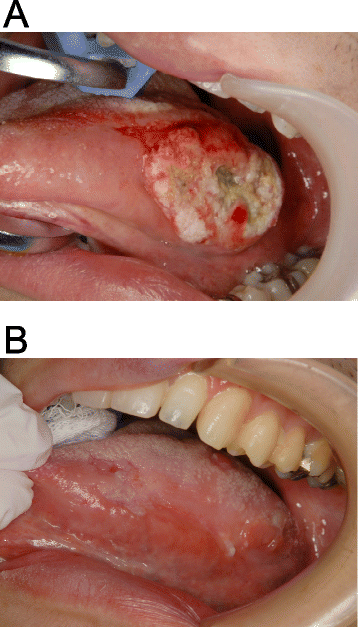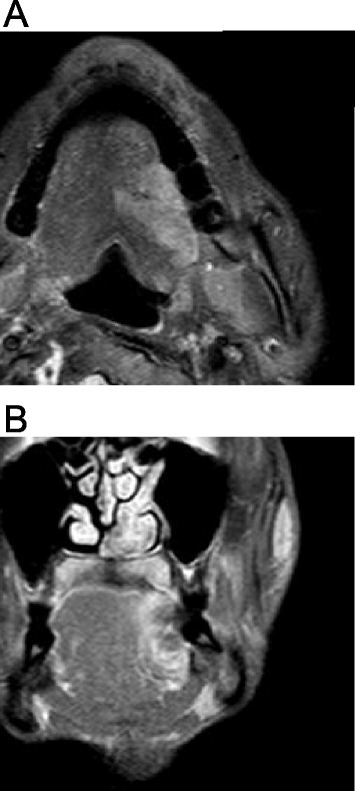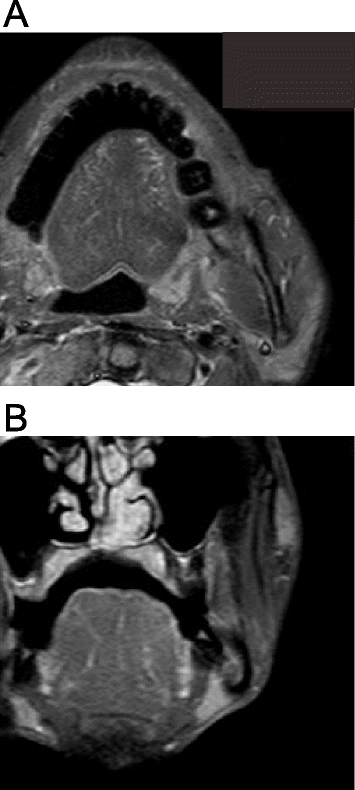Tongue cancer with mental retardation due to microcephaly: a clinical report
- PMID: 26179630
- PMCID: PMC4504062
- DOI: 10.1186/s12957-015-0634-2
Tongue cancer with mental retardation due to microcephaly: a clinical report
Abstract
Oral cancer in patients with mental retardation has not been reported in detail, although the literature on clinical management of oral malignancies in the general population is extensive. No clear consensus has been established regarding the management of oral cancer in patients with mental retardation. We present herein the case of a 32-year-old Japanese man with mental retardation due to microcephaly who presented with advanced tongue cancer. He was treated with three courses of chemotherapy using superselective intra-arterial infusion of cisplatin at 100 mg/m2 via the femoral artery (Seldinger method). No major complications were encountered, and complete response was achieved. The patient has shown no clinical or radiological evidence of local recurrence or distant metastases as of 22 months after the end of treatment. This case provides a basis for the future appropriate management of oral cancer in patients with mental retardation.
Figures



Similar articles
-
Chemotherapy using intra-arterial infusion for oral cancer.Nagoya J Med Sci. 2006 Jun;68(3-4):101-8. Nagoya J Med Sci. 2006. PMID: 16967775 Review.
-
Thermochemoradiotherapy using superselective intra-arterial infusion for N3 cervical lymph node metastases of tongue cancer.J Cancer Res Ther. 2013 Oct-Dec;9(4):718-20. doi: 10.4103/0973-1482.126465. J Cancer Res Ther. 2013. PMID: 24518725
-
Efficacy of multidrug superselective intra-arterial chemotherapy (docetaxel, cisplatin, and 5-fluorouracil) using the Seldinger technique for tongue cancer.Acta Otolaryngol. 2012 Oct;132(10):1108-14. doi: 10.3109/00016489.2012.684702. Acta Otolaryngol. 2012. PMID: 22998559
-
[Combination therapy of fluoropyrimidine (TS-1) administration and selective intra-arterial cisplatin infusion for tongue carcinoma--a case report].Gan To Kagaku Ryoho. 2003 Apr;30(4):511-4. Gan To Kagaku Ryoho. 2003. PMID: 12722683 Japanese.
-
Rhabdomyosarcoma of the tongue: report of a case and review of the literature.Pediatr Hematol Oncol. 2011 Feb;28(1):60-4. doi: 10.3109/08880011003749678. Epub 2010 May 14. Pediatr Hematol Oncol. 2011. PMID: 20469976 Review.
Cited by
-
Intraoral myoepithelial carcinoma in a young man with intellectual disability: A highly rare and challenging case.J Dent Sci. 2024 Jul;19(3):1888-1889. doi: 10.1016/j.jds.2024.05.015. Epub 2024 May 20. J Dent Sci. 2024. PMID: 39035287 Free PMC article. No abstract available.
References
-
- Satge D, Clemenson P, Nishi M, Clemenson A, Hennequin M, Pacaut C, et al. A mucoepidermoid carcinoma in a young man with intellectual disability: review of oral cancer in people with intellectual disability. Oral Surg Oral Med Oral Pathol Oral Radiol. 2013;115(5):e22–7. doi: 10.1016/j.oooo.2012.10.010. - DOI - PubMed
Publication types
MeSH terms
LinkOut - more resources
Full Text Sources
Other Literature Sources

